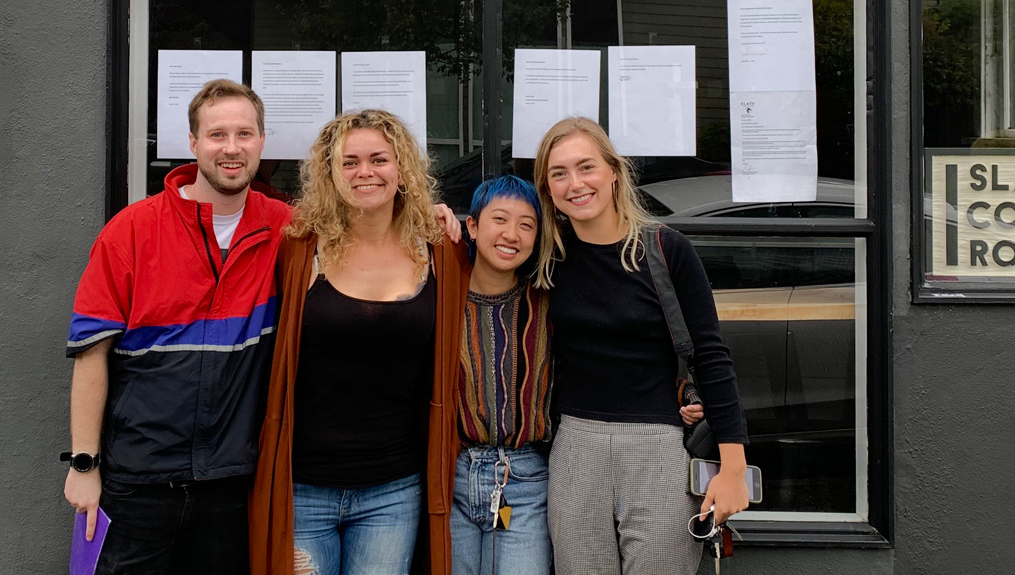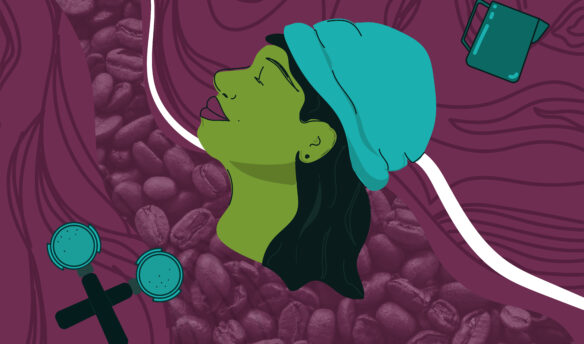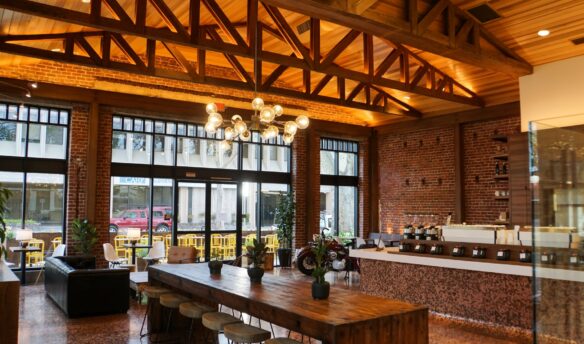The Coffee At Large crew at the June 22nd walkout. From left to right: Jason Beutler, Sam Capell, Felix Tran, and Rachel Hopke. Photo courtesy of Coffee At Large.
[T]hree months ago, six employees of Slate Coffee Roasters in Seattle arrived early at the Ballard location, not to clock in, but to walk out. They taped letters of resignation to the windows, locked the doors, and regrouped at a neighboring café to launch @coffeeatlarge (CAL), an Instagram account that reached over 200 followers in minutes. It now boasts over 8k followers.
Felix Tran, who worked at the coffee roaster for a year and a few months, had witnessed a barista exodus from Slate soon after he was hired in the summer of 2018.
“Every year there’s a wave of people who quit and leave,” he explains. “Every year [they] get more and more fed up with it.”
The main reasons were missing or late paychecks, lack of transparency and communication from management, and a hostile work environment. Samantha “Sam” Capell, a former manager at Slate who bore the brunt of the pressure from higher-ups for over two years, originally thought of the walkout. It was supposed to happen a month later, but when Capell was fired, the crew mobilized to pull it off that same week on June 22.
At the nearby café after the walkout, the group posted pictures of their letters of resignation on the new Instagram profile, along with Tran’s original artwork of hands held wreathed by coffee cherries, and responded to DMs, which turned into an all-day project.

“We stayed [at the café] until they closed,” Rachel Hopke remembers. “So we were just sitting there on our laptops. By the end, the barista finally walked up to us, because we had our photo posted of us in that café, and the barista working there came up with their iPhone and showed us the picture, ‘Is this you?’”
That’s just one example of how quickly word spread about Coffee At Large. It helped that groups like #coffeetoo, Coffee People Zine, Boss Barista, and industry pro Umeko Motoyoshi all championed their cause, boosting CAL on their social media. Messages of support started rolling in, as well as other coffee workers’ stories of their experiences of unjust work environments. No one seemed to know just how big @coffeeatlarge was going to become, but it quickly turned into a platform for sharing, support, and solidarity.
The months after the walkout were a flurry of meetings with labor organizers, including the Democratic Socialists of America’s Seattle chapter. CAL also hosted events “What Are Labor Rights?” at the July release of the Coffee People Zine, and “Getting To Know Coffee At Large” in August in Seattle. Some members of the original group have stepped back, and Capell has since moved out of state, but CAL has seen enough momentum and positive feedback from the community to continue forward, as well as adding its first remote chapter @bitchy.baristas in Cincinnati.
“People have asked ‘How can we be a chapter?’ And our answer to them over social media has been: If you have a group of people, email us and show us what your goals are and what events or work you envision doing,” says Hopke, adding that potential volunteers or chapters have to agree on the CAL code of ethics, or create one of their own. “One of the benefits of chapters is that different cities have different needs, and the best people to fill those needs or see those problems are gonna be in that city. More power to them if they want to use whatever Coffee At Large can give them.”
Aside from documenting baristas’ experiences, the Instagram account has become an important way to share information and resources for those in the industry.
“As we get deeper into the activism part of coffee, there’s just so many things that people are doing, and we acknowledge our platform and how many followers we have,” says Tran. “Personally, I want to share all these things that people are doing in an [easily digestible] way, [while] not being overwhelmed, but ‘This is something you should look into.’”
According to Hopke and Tran, future plans include a Coffee At Large website, zine, and podcast, as well as some other proposed collaborations. On top of full-time, unpaid, CAL work, members also work full-time at different cafés. To make their work sustainable, CAL has increased its ranks to 16 volunteers, added a treasurer, Kevin Wren, who is also involved in the activist group #insullin4all, and started a GoFundMe, where they have already exceeded their goal. A big part of the funds raised will go towards securing an attorney to help guide them through the legal process of becoming a 501(c)(3) nonprofit.
Catch the Coffee At Large crew at this Thursday’s Badass Barista Throwdown in Seattle, hosted in conjunction with Joe.Coffee App and El Diablo Coffee, the proceeds from which go to the Glitter Cat Barista Bootcamp.
*Slate Coffee Roasters was contacted, but did not respond for this article.
















